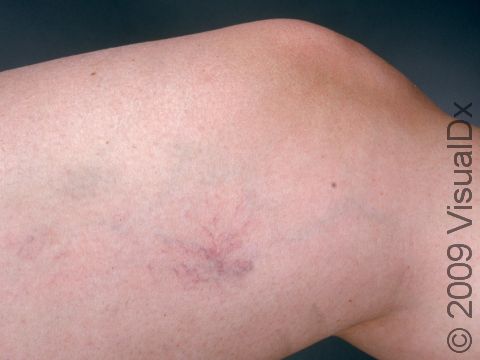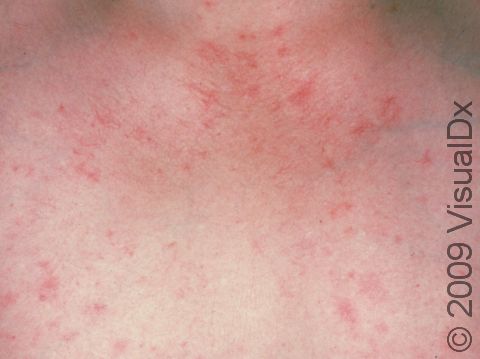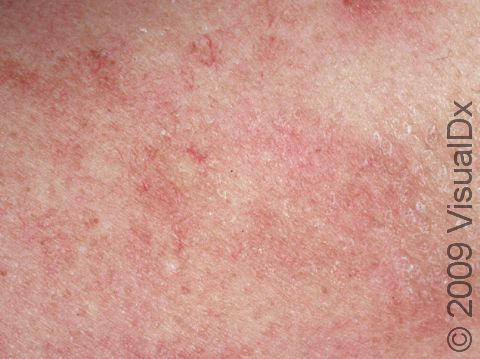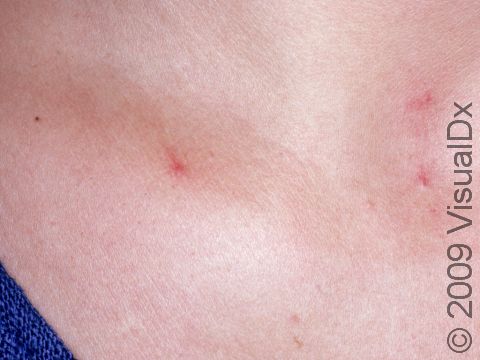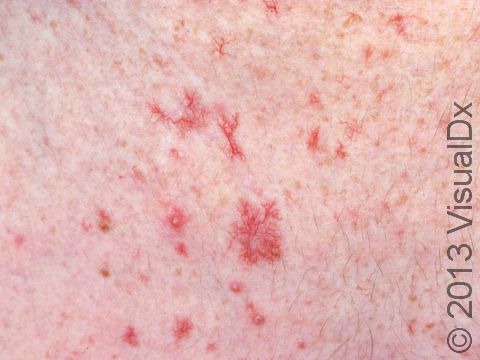Telangiectasia
Telangiectasias are widely open (dilated) blood vessels in the outer layer of the skin. When seen on the legs, they are often called spider veins.
Who's At Risk?
Telangiectasias are very common in healthy people and are usually caused by sun damage or aging. When seen on the legs, they do not necessarily indicate a vein disorder, such as varicose veins or underlying deep vein problems. However, they are seen with a number of diseases, including acne rosacea, birthmarks (eg, port-wine stains), scleroderma, several types of inherited disorders (ataxia-telangiectasia, hereditary hemorrhagic telangiectasia, xeroderma pigmentosum, and others), or with prolonged use of oral or topical corticosteroids.
Signs & Symptoms
Telangiectasias can be seen anywhere on the body. They are common on the face (nose, cheeks, and chin) and legs (particularly the thighs, just below the knees and the ankles).
Telangiectasias are red, blue, or purple linear marks measuring less than 1–3 mm in width and several millimeters to centimeters in length, and they can disappear temporarily if you press on them with your finger.
Self-Care Guidelines
No treatment is necessary unless the appearance is bothersome.
You might try the following:
- Use cover-up makeup or self-tanning lotion to cover them up. Waterproof leg makeup is also available.
- If in a sun-exposed area, use sun-protection measures, such as a hat or sunscreen.
- If you have been using topical corticosteroid cream, stop its use on the affected area.
Treatments
If you are concerned about a potential disease causing the telangiectasias, blood tests and evaluations of family members may be done.
If you have acne rosacea, oral or topical antibiotics may be prescribed.
The appearance of telangiectasias may be improved by laser treatments and burning (electrocautery).
Laser treatment of telangiectasias on the leg is more difficult and may leave marks. Injection of chemicals to cause scarring in the blood vessel, thereby closing it (sclerotherapy), is often preferred for treating spider veins.
Visit Urgency
See your doctor if you have a family history of similar marks, any personal or family history of bleeding from the gastrointestinal tract, lesions on the mouth or eye lining, or repeated bleeding from a lesion.
If the lesions are cosmetically displeasing, you may want to seek medical advice for treatment, although treatment for telangiectasias is usually not covered by insurance.
Trusted Links
References
Bolognia, Jean L., ed. Dermatology, pp.1653-1654, 2406. New York: Mosby, 2003.
Freedberg, Irwin M., ed. Fitzpatrick’s Dermatology in General Medicine. 6th ed. pp.1003, 1012-1014, 1216. New York: McGraw-Hill, 2003.
Last modified on October 10th, 2022 at 4:42 pm

Not sure what to look for?
Try our new Rash and Skin Condition Finder
